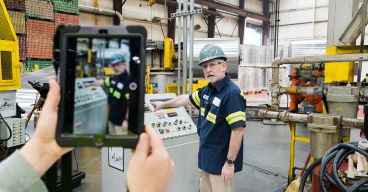Combating Labor Shortages by Digitizing Institutional Knowledge

As America continues the shift to more of a service economy, manufacturing companies have dealt with numerous challenges, and among the most consistent is labor shortages. This problem will only worsen as a key generation of workers retires. In response, many manufacturers are capturing and digitizing knowledge of experienced workers before they walk out the door.
More than a quarter of today’s manufacturing workforce is made up of Baby Boomers, born between 1946 and 1964. As these workers retire, companies face a massive brain drain that can put their operations and their people at risk.
Companies can encourage older frontline employees to extend their work careers and delay retirement where possible. And they can recruit younger employees and pair them to learn from their senior co-workers. (Unfortunately, post-COVID environment has made hiring in many sectors even more challenging.) But the former simply kicks the can down the road, and the latter brings in employees who don’t have the key institutional knowledge these older workers possess.
Every plant manager will have a small number of employees who know the machines, processes, maintenance, and methods like no other. Often, this special knowledge is not captured in any documented procedure, SOP, or training program. These special – critical – workers may be nearing retirement age, which you can plan for. But no matter their age, they could leave the company at any time, or worse, be taken out by health issues or an accident. To safeguard the future of the company, it’s important to capture this institutional knowledge before it’s too late.
This looming mass retirement has been easy to predict, and it’s now close. Because of this, many companies have efforts to facilitate the knowledge transfer to younger workers. Sixty-Nine percent of companies have on-the-job training programs. Mentorship and apprenticeship programs have also been popular. Not only do they help share the skills and information, but they are also fulfilling to older workers, which frequently keeps them on board longer. The problem with all of these is they don’t scale and they aren’t documented.
The best digital documentation in most cases is going to be in the form of a video shot on the plant floor where the subject matter expert (SME) is most comfortable and the equipment to demo is at hand. The key for proper knowledge transfer is to effectively turn that video into an interactive training course. The source video is the foundation, but it needs instruction added, text reinforcements, and built-in quizzes to ensure the new trainee has understood the training content. The end result is education that can be delivered to any worker at any time, right on the floor where they’ll be performing the work.
Fortunately, video technology has matured to where nearly everyone can shoot a good enough quality video with a device in their pocket or purse. When combined with an on-the-job (OJT) course-authoring app, this convenience of phone and tablet cameras makes capturing knowledge and skills of retiring workers easier. But a manager must still think on and plan the topics to capture, the priorities, and when and where to shoot the videos. That’s where you can engage your senior workers to help craft the plan of what special knowledge there is to share. You will commonly find among them a desire to leave a legacy and being captured on video is a true tangible way to have an impact and be part of the organization for years to come.
These OJT training courses can provide immediate benefits by using them to train employees working in the plant today. This will have engagement and retention benefits as workers increase their knowledge and contribution. Further, once you have more workers trained, you will have backups to help keep the production line going if a more experienced, key resource is temporarily out. If you are increasing your hiring to address the labor shortage, these OJT video courses can also be used to easily ramp up new workers more quickly and further spread the historical knowledge.
Much like classroom or eLearning training programs, OJT video courses alone will not be sufficient for passing the information and expertise. Knowledge assessments, validations, and reinforcement must be part of the program. If you are already employing these techniques, it could be easy to extend them to the OJT video format.
If you’re looking to accelerate such an effort and greatly diminish the risk of this impending older worker exodus, consider the Alchemy Playbook solution. Built for phones and tablets, the app lets you create, deliver, and validate job-specific training on the production floor.





